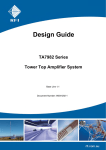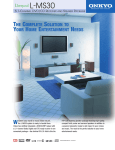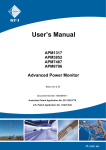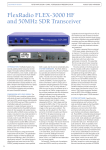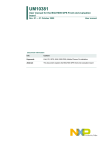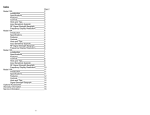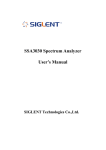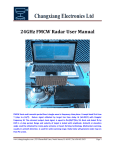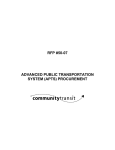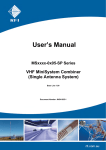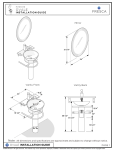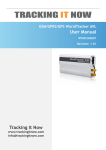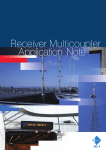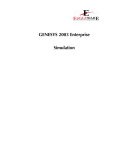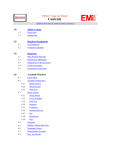Download User`s Manual TTA01 - RFI
Transcript
User’s Manual TA7982 Series Tower Top Amplifier System Base Line 1.30 Document Number: INS41590-1 TA7982-01xx-12-xx Series User’s Manual Company Overview RFI has been serving the needs of the wireless communications market for over 30 years. First founded as a manufacturer of antenna systems, RFI has grown to be a key player in the development, manufacturing and distribution of wireless technology and energy products. Through our extensive network of resellers, systems integrators and retail outlets, RFI is a key supplier to both industry and Government. Our research and manufacturing facilities have talented people, sophisticated test equipment, state of the art software with class leading manufacturing systems and techniques. Additionally, we have in place a quality management program which is certified to ISO9001, environmental management system certification to ISO14001 and occupational health and safety standard AS4801 giving you complete confidence in everything we do. RFI’s products are truly innovative and as a result we are active around the globe taking our Australian designed and manufactured products to key markets in Asia Pacific, the Americas and EMEA regions via offices ‘in-region’ in addition to exporting directly to in excess of 50 countries. One of RFI’s key principals is to remain totally customer focused as we recognise our future depends on the success of our customers. We know that to be chosen as your supplier we must add value to your business and to achieve this we will work hard to deliver the best product when and where you need it and back this up with the very best technical support available. Asia Pacific | EMEA | Americas 2 TA7982-01xx-12-xx Series User’s Manual Document Number INS41590-1 Copyright ã 2013 RF Industries Pty Ltd First Printing: 20th May 2013 Version Number Version Date 1.00 20th May 2013 1.20 19th November 2013 1.30 27th February 2014 _____________________________________________________________________________ Acknowledgements Modified extracts of the Motorola Five Step Process for Receive System Verification documented process are reproduced with permission. Disclaimer Product part numbering in photographs and drawings is accurate at the time of printing. Part number labels on RFI products supersede part numbers given within this manual. Information is subject to change without notice. Asia Pacific | EMEA | Americas 3 TA7982-01xx-12-xx Series User’s Manual TABLE OF CONTENTS 1. GENERAL DESCRIPTION .............................................................................................................. 7 2. TTA - ELECTRICAL AND MECHANICAL SPECIFICATIONS ............................................... 9 3. RMC - ELECTRICAL AND MECHANICAL SPECIFICATIONS ............................................ 10 4. ORDERING INFORMATION ........................................................................................................ 12 5. INTERCONNECTION DIAGRAMS ............................................................................................. 13 6. TTA SYSTEM RF OUTPUT CAPACITY EXPANSION............................................................. 16 7. UNPACKING.................................................................................................................................... 19 8. FIRMWARE LICENSE AGREEMENT ........................................................................................ 20 9. INSTALLATION .............................................................................................................................. 21 10. OPERATION .................................................................................................................................. 24 11. COMMISSIONING ........................................................................................................................ 25 12. MANUAL SETUP AND OPERATION ........................................................................................ 31 12.1 Rear Panel Switches and LED Indicators .........................................................................................31 12.2 Front Panel Switches and LED Indicators ........................................................................................34 13. GUI SETUP AND OPERATION .................................................................................................. 36 13.1 Ethernet Connection Set-up ...............................................................................................................36 13.2 Log In Page ..........................................................................................................................................39 13.3 System Overview .................................................................................................................................40 13.4 Status Detail Menu ..............................................................................................................................41 13.5 Status Detail - RMC ............................................................................................................................42 13.6 Status Detail - TTA..............................................................................................................................44 13.7 Status Detail – System .........................................................................................................................46 13.8 Status Detail – Communications ........................................................................................................48 13.9 History Menu .......................................................................................................................................50 13.10 History – Performance Record .........................................................................................................51 13.11 Configuration Menu ..........................................................................................................................53 13.12 Configuration - RMC ........................................................................................................................54 13.13 Configuration – TTA .........................................................................................................................58 13.14 Configuration – User Data ................................................................................................................60 13.15 Configuration – Communications ....................................................................................................61 13.16 Maintenance Menu ............................................................................................................................63 13.17 Maintenance – Access Management ................................................................................................64 13.18 Maintenance – Date & Time .............................................................................................................66 13.19 Maintenance – Firmware Update.....................................................................................................67 13.20 Maintenance - Restart .......................................................................................................................68 13.21 About ..................................................................................................................................................69 13.22 Logout.................................................................................................................................................70 14. CONNECTORS .............................................................................................................................. 71 15. MAINTENANCE, INSPECTION AND REPAIR ADVICE....................................................... 72 16. BACKGROUND MATERIAL AND OTHER RESOURCES .................................................... 73 17. USER NOTES: ................................................................................................................................ 74 Asia Pacific | EMEA | Americas 4 TA7982-01xx-12-xx Series User’s Manual Notice The information contained in this document is subject to change without notice. RF Industries Pty. Ltd. makes no warranty of any kind with regard to this material, including but not limited to, the implied warranties of merchantability and fitness for a particular purpose. RF Industries Pty Ltd shall not be liable for errors contained herein or for incidental or consequential damages in connection with the furnishing, performance or use of the material. All information contained in this manual has been reviewed. However RF Industries Pty Ltd accepts no liability for any omissions, errors or construed information. Ó 2012, RF Industries Pty Ltd. All rights reserved. Reproduction, adaptation or translation without prior written permission is prohibited except as allowed under copyright laws. For further information or help with this product contact your nearest RFI sales office or through the following; Region USA EMEA ASIA PACIFIC Sales email Tech Support Telephone Intl Telephone local Fax Intl Web [email protected] [email protected] +1 (330) 486 0706 330 486 0706 + 1 (330) 486 0705 rfiamericas.com [email protected] [email protected] +44 1869 255 772 01869 255 772 rfiemea.com [email protected] [email protected] +61 7 3621 9400 1300 000 RFI +61 2 9630 0844 rfi.com.au Asia Pacific | EMEA | Americas 5 TA7982-01xx-12-xx Series User’s Manual TT7982-01xx-12-AC Series Tower Top Amplifier Unit Front View Bottom View Receiver Multicoupler Unit Front View Rear View Asia Pacific | EMEA | Americas 6 TA7982-01xx-12-xx Series User’s Manual 1. General Description The TA7982 Series are full-featured, high performance systems comprising a Tower Top Amplifier (TTA) and a Receiver Multicoupler/TTA Controller unit (RMC). The TTA unit features a milled cavity bandpass preselector providing exceptional selectivity (>110dB) and a 28MHz bandwidth (796-824MHz). Redundant quadrature low-noise amplifiers are included to overcome the system’s feeder cable losses. An IP-rated milled aluminium housing provides excellent environmental ratings and the housing’s small size also provides installation tower loading efficiency. Lightning surge protection is internally fitted to the TTA. Each TTA amplifier stage is monitored to provide alarm indications in the event of failure, and to initiate automatic change-over between the redundant amplifier paths. The status of these amplifier alarms, in addition to TTA temperature, TTA power supply voltages, and other operational conditions, are sent to the RMC via the “Main” coaxial feeder cable between the TTA and RMC, using an interface signalling protocol. DC power for the TTA is also sourced from this cable. Figure 1 - TTA Block Diagram The TTA’s operating configuration can be controlled using either the user-friendly front panel switches, or via a local (or remote) IP connection using the integral webserver Graphical User Interface (GUI) of the interconnected RMC. A Test Port is provided on the TTA unit to facilitate TTA system testing from the ground equipment room. A 30dB coupler in the TTA allows a signal to be injected to test the performance of both amplifier RF paths, and a Test function allows measurements to be compared between a termination and the receive antenna to determine the effective sensitivity of the network’s receiver system (refer Motorola Five Step Process for Receive System Verification). A Bypass capability is also included in the TTA Test Mode to allow both RF amplifiers to be bypassed during system testing. This Bypass feature will time out after the user-configurable time period (factory default is 1 minute) to ensure the system is not inadvertently left in this test mode. RF path switching between the redundant amplifiers allow the RF signal path to be changed automatically using the auto changeover feature, or manually using the RMC front panel switches or via GUI control. Manual changing between amplifier paths may also be actioned for testing purposes, or for equipment life cycle sharing between the two amplifiers’ circuitry. Asia Pacific | EMEA | Americas 7 TA7982-01xx-12-xx Series User’s Manual The RMC/TTA Controller (a.k.a. “RMC”) provides a power supply and signalling interface to the TTA, monitoring of the TTA’s operational status and alarms and receive signal distribution to multiple base station receivers. It includes adjustable gain to overcome the distribution cabling losses within the equipment building. Configuration of the RMC is provided using rear panel rotary switches and configuration of the RMC/TTA Controller is provided using front panel switches. Rear panel LED indicators show the status of power - and the use of the optional post filter (if used). Front panel LED indicators show the status of power, TTA and RMC Fault status, the selected TTA amplifier path, Term and Bypass modes, and whether the RMC is under Switch or LAN configuration control. In addition, SNMP and Form-C relay outputs are provided for interfacing to an alarm management system. The RMC has adjustable attenuators for both Input and Distribution (Output) gain settings, adjustable in 1dB increments. Rear panel CONFIG, INPUT GAIN ATTEN, and DIST. GAIN ATTEN switches provide a simple and convenient method of configuring the RMC to meet Motorola’s guidelines for both Reserve (Input) gain, and Distribution gain for the number of base stations connected to the TTA system. The RMC unit distributes signals to 8 base station receivers (9 in Config Mode 2 – refer Section 12), and it can be easily field expanded to cater for up to 128 base station receivers using additional 8way RMC Expansion Multicoupler which may be ordered separately as required. Default TTA/RMC configurations are capable of 8 (or 9) and 16 outputs, but other output capacities may be easily ordered to suit system requirements. ESS and mixed non-ESS/ESS base station equipment can be supported using Config Modes 6 and 7. Figure 2 - RMC Block Diagram A Test Port is provided on the RMC front panel to be used in conjunction with the TTA’s Bypass mode to sweep the receive antenna system and antenna using a distance-to-fault (DTF) test set. If desired, an integral web-server Graphical User Interface (GUI) resident in the RMC may also be used to configure the TTA/RMC and to monitor the status of alarms and TTA/RMC operation. This webserver can be accessed locally or remotely via TCP/IP network (or Internet) access. For software developers, a Command Line Interface (CLI) textbased command set is also available for interfacing to the TTA/RMC using a computer/workstation/mainframe and a Telnet session if desired. New features can also be easily implemented via firmware upgrades using the GUI or CLI. These TTA systems are available in 12VDC, 24VDC, 48VDC or 90-264VAC versions to suit different network or site power systems. Supporting documents including this User Manual, a Quick Start Guide (QSG), Design Guide and SNMP MIB files are also available from RFI. Asia Pacific | EMEA | Americas 8 TA7982-01xx-12-xx Series User’s Manual 2. TTA - Electrical and Mechanical Specifications TTA Model Number TA7982-0100-10-00 Frequency Band 700 / 800MHz Preselector Included Yes Preselector Frequency Range 796–824MHz Preselector Selectivity (High) >110dB @ 851MHz Preselector Selectivity (Low) >110dB @ 776MHz Type of Amplifier Quadrature Coupled Amplifier Switching Automatic (configurable) Type of Amplifier Switching Solid State RF Switch TTA Gain (input to output of TTA) 25dB +/-1dB Noise Figure (Amplifier) <1.5dB (1dB typ.) Noise Figure (TTA) <2.7dB typ. <3.5dB (includes TTA, 6dB feeder, and RMC) Noise Figure (System) TTA Amplifier IIP3 >+15dBm Return Loss (All Ports) >14dB Power Requirements Power Derived from “Main” port coaxial cable Operating Temperature Range Operating Temperature Range (with minor performance degradation) Redundancy -22°F to 140°F / -30°C to +60°C -22°F to 158°F / -30°C to +70°C Automatic Changeover (configurable) Lightning Protection 20kA IEC 61000-4-5 8/20uS Test Port Included Yes Isolation (Coupling) of Test Port 30dB +/- 2dB 50ohm Termination Test Yes (Receiver Multicoupler controlled) Type of RF Test Switching Solid State RF Switch Bypass Test Mode Yes (Receiver Multicoupler controlled) Connectors (All Ports) N-type (female) Enclosure NEMA Weather resistant housing Table 1 Asia Pacific | EMEA | Americas 9 TA7982-01xx-12-xx Series User’s Manual 3. RMC - Electrical and Mechanical Specifications Receiver Multicoupler Model Number RX6996-3408-34-xxB Frequency range 698-960MHz 8 (expandable to 128) Number of RF Output Ports Expansion Port Yes 0 to +4dB (-19 to +11dB available) Net Gain or Loss (RMC In to RMC Out) Amplifier Type Quadrature Coupled Amplifier Noise Figure 4dB max. (<1.9dB typ.) rd Amplifier Output 3 Order Intercept Point (3OIP) >45dB (48dB typ.) 8way (field expandable to 128 way) Supports ESS-only and mixed mode non-ESS/ESS operation Number of Output Ports RF Port Return Loss (All Ports) >14dB Connectors (to TTA) N-type (female) Receiver Connector BNC-type (female) Rx-Rx Port Isolation >20dB Receive Test Port Yes Test Port Input (front of Receiver Multicoupler) BNC-type (female) Test Port Output (rear of Receiver Multicoupler) N-type (female) Reserve (Input) Gain electronic attenuator 15dB (in 1dB steps) Distribution Gain electronic attenuator 4dB (in 1dB steps) Internal SMT surge protection to supplement building entry point protection Lightning Protection Form-C contacts (n.o./n.c. 1A 60V) SNMP V2c (Northbound Traps) 3pin Phoenix style (locking) Alarms Alarm Connector Communications Connector TCP/IP Ethernet port (RJ45) Indicators Power Requirements Front panel LED's 12VDC nom. (10VDC to 18VDC floating) 24VDC nom. (18VDC to 36VDC floating) 48VDC nom. (36VDC to 60VDC floating) 90-264VAC 50/60Hz (plug pack on 12VDC model) 2.5A @ 12VDC 1.3A @ 24VDC 650mA @ 48VDC DC Current Consumption (including TTA) DC Connector 2pin Phoenix style (locking) M6 stud (on RHS of rear panel) M5 screw (on LHS of rear panel) Earthing Operating Temperature Range 32°F to 122°F / 0°C to +50°C 1RU 19inch Rack mount (8way) 2RU 19inch Rack mount (16way) Mounting Dimensions (W x H x D) 19 x 1.75 x 5.9” / 483 x 44.75 x 150mm (8way) 19 x 3.5 x 5.9” / 483 x 89.5 x 150mm (16way) Table 2 Asia Pacific | EMEA | Americas 10 TA7982-01xx-12-xx Series User’s Manual Expansion Multicoupler - Electrical and Mechanical Specifications Receiver Multicoupler Model Number RX0696-3008-31B Frequency range 60-960MHz Number of RF Output Ports 8 RF Port Return Loss (All Ports) >14dB Connectors BNC-type (female) Rx-Rx Port Isolation >20dB Power Requirements None (Passive) Operating Temperature Range 32°F to 122°F / 0°C to +50°C Mounting 1RU 19inch Rack mount Dimensions (W x H x D) 19 x 1.75 x 5.9” / 483 x 44.75 x 150mm Table 3 Mains Power Supply - Electrical and Mechanical Specifications Plug Pack Power Supply RXTA0000-3060US-AC Input Voltage 90-264VAC 50/60Hz Input Plug IEC Input Cable 1.5m long USA plug Output Voltage 12VDC @ 5A (60W) Output Connector 2pin Phoenix style (locking) Mounting Free-standing Dimensions (W x H x D) 5 x 1.25 x 2” / 125 x 31.5 x 50mm Table 4 Asia Pacific | EMEA | Americas 11 TA7982-01xx-12-xx Series User’s Manual 4. Ordering Information Ordering Information System Model Numbers Motorola E-CAT Part Number DSTA7982010812AC DSTA7982011612AC RFI Part Number Description TA7982-0108-12-AC TTA/RMC in “TTA01/RMC01” configuration 8 Port Receiver Multicoupler & Tower Top Amplifier 796-824MHz, 90-264VAC (complete with RXTA0000-3060US-AC Plug Pack Power Supply) TA7982-0116-12-AC TTA/RMC in “TTA01/RMC01” configuration 16 Port Receiver Multicoupler & Tower Top Amplifier 796-824MHz, 90-264VAC (complete with RXTA0000-3060US-AC Plug Pack Power Supply) Separate Items Motorola E-CAT Part Number RFI Part Number DSTA798201001000 TA7982-0100-10-00 DSRX6996340834ACB RX6996-3408-34-ACB DSRX0696300831B RX0696-3008-31B 8 Port Expansion Multicoupler, 66-960MHz, BNC Connectors DSRXTA00003060USAC RXTA0000-3060US-AC 90-264VAC 50/60Hz 12VDC Plug Pack Power Supply c/w 1.5m IEC cable with USA plug Description TTA in “TTA01” configuration Tower Top Amplifier, 796-824MHz RMC in “RMC01” configuration 8 Port Receiver Multicoupler, 698-960MHz, 90-264VAC (complete with RXTA00003060US-AC Plug Pack Power Supply) Table 5 Asia Pacific | EMEA | Americas 12 TA7982-01xx-12-xx Series User’s Manual 5. Interconnection Diagrams The TA7982 series of TTA systems are designed to be mounted into a wide range of configurations. The Interconnection Diagrams (Figures 3 and 4) show two examples. Figure 3 – TA7982-0108-12-xx Configuration (Config Switch position 1 and 2) Asia Pacific | EMEA | Americas 13 TA7982-01xx-12-xx Series User’s Manual Figure 4 – TA7982-0116-12-xx Configuration (Config Switch position 3, 4 and 5) Asia Pacific | EMEA | Americas 14 TA7982-01xx-12-xx Series User’s Manual Receive Antenna Tower Top Amplifier Ant Test Main Receiver Multicoupler (Optional) Post Filter Filter Filter Test Port RF Input Test Port Lightning Surge Protectors To Expansion Multicouplers for capacities >8 channels RF Outputs Selection Pushbuttons Exp Port Alarm Ethernet I/Face 10dB To ESS Equipment Rack To Site Alarm Management System Power DC In DC or AC Power AC In Plug Pack Figure 5 – TA7982-0116-12-xx Configuration (Config Switch position 6 and 7) Asia Pacific | EMEA | Americas 15 TA7982-01xx-12-xx Series User’s Manual 6. TTA System RF Output Capacity Expansion The TTA system RF output capacity may be easily expanded. Channel capacities from 8 through to 128 channels can be easily catered for, with expansions being easily and conveniently implemented on-site - as required by future network expansion. To optimize site cabling material and installation effort, 8-way Expansion Multicouplers may be “distributed” around a site equipment room, with one (or more) Expansion Multicouplers installed in each 19inch cabinet, with short interconnect cables then being run between that cabinet’s Expansion Multicoupler and the base station receivers colocated in that cabinet. Figure 6 - Receiver Multicoupler configuration for up to 8 (or 9) base station receivers Asia Pacific | EMEA | Americas 16 TA7982-01xx-12-xx Series User’s Manual Figure 7 - Receiver Multicoupler configuration for up to 16 base station receivers Figure 8 - Receiver Multicoupler configuration for up to 64 base station receivers (using multiple 8way Expansion Multicouplers for desired capacity) Asia Pacific | EMEA | Americas 17 TA7982-01xx-12-xx Series User’s Manual Figure 9 - Receiver Multicoupler configuration for up to 128 base station receivers (using multiple 8way Expansion Multicouplers for desired capacity) Asia Pacific | EMEA | Americas 18 TA7982-01xx-12-xx Series User’s Manual 7. Unpacking The TTA and RMC units are packed in custom designed cardboard packaging, together with an AC to DC power pack (if the AC option has been ordered). Packed with the units will be the Factory Test Sheet (FTS) and Quick Start Guide (QSG). The User’s Manual will be included on a USB memory stick. It is recommended to retain the Factory Test Sheet for future reference. An Ethernet jumper cable is included in the RMC packaging, provided for your convenience to connect and configure the TTA and RMC via the RMC Graphical User Interface (GUI). Although the packaging has been designed to provide suitable product protection during shipping, it is important to report any visible damage to the carrier immediately. It is the customers’ responsibility in the event of product damage, to lodge a damage claim with the carrier within a short period of time after receipt of the package. The time window for lodging the claim should be ascertained from the specific carrier as this may vary between carriers (typically 1 to 5 days). Please dispose of all packaging material responsibly. Asia Pacific | EMEA | Americas 19 TA7982-01xx-12-xx Series User’s Manual 8. Firmware License Agreement This statement must be read in its entirety prior to the loading or use of the Firmware provided by RFI. Introduction. By loading any product related Firmware you agree without reserve with all the conditions as detailed in this RFI Firmware License Agreement. The term “Firmware” for the sake of this statement includes all software or firmware upgrades, either as a new installation, revision, patches or upgrades. Any reference to software, for the purposes of this license agreement, will therefore be included in the term Firmware. RFI refers to the Australian registered company RF Industries Pty Ltd. The copyright of all Firmware relating to this product remains the property in whole of RFI and is therefore protected by the respective international copyright or trademark laws. You agree that by using and or downloading any of the RFI product specific Firmware, that you have fully understood and agree to comply and be bound by the all of the conditional requirements as detailed in this Firmware License Agreement and accept the disclaimer thereof. RFI reserves the right to update and change, from time to time, any attribute, function, feature and in the main any content of the Firmware and any documentation attributed and referenced to the Firmware underwritten by this Firmware License Agreement without notice to existing users. The use of this Firmware is non-exclusive and non-sub licensable, nor does it give the user the right to re-sell, lease, loan, distribute, or transfer the Firmware nor the rights thereof. This Firmware License Agreement grants or implies no right, title, or interest in any intellectual property owned or licensed by RFI. Support and Firmware Updates. RFI may elect to provide you with customer support and/or Firmware upgrades, enhancements, or modifications for the RFI Firmware at its sole discretion, and may terminate such support at any time without notice to the user. RFI may change, suspend, or discontinue any aspect of the Firmware at any time, including the availability of any Firmware feature, database, or content. From time to time RFI may provide notice through the RFI web site of any available updates or Firmware revision downloads. Fees. RFI reserves the right to charge fees for upgrades or revisions of the applicable Firmware download. Disclaimer. Use of any Firmware enabling operation of the product or providing support for the product is at the user’s discretion and risk. RFI will not be held responsible or liable for any damage or loss that results from the downloading and or use of the Firmware or incompatibilities or other problems experienced as a result of any combination of operating system(s), firmware, or software the user may use. RFI will not be held responsible or liable for any inaccuracies, completeness or inadequacy regarding the Firmware as the basis of the provision of the Firmware is on a “fit-for-purpose, best effort” approach. RFI will not be liable to the user for claims and liabilities of any kind arising out of or in any way related to the use of the Firmware by the user or any third party. The failure of RFI to exercise or enforce any right or provision of this Firmware License Agreement shall not constitute a waiver of such right or provision. Asia Pacific | EMEA | Americas 20 TA7982-01xx-12-xx Series User’s Manual 9. Installation Note: All installation works and practices should be carried out by qualified personnel and in compliance to the Motorola R56 standard. TTA Installation The use of appropriate TTA mounting hardware that suits the installation’s specific tower or mast installation scenario is important. The TTA is provided with a general purpose stainless steel mounting bracket that enables the TTA to be installed onto many antenna booms, mounting head frames, poles, masts, tower spaces, or flat surfaces (such as building parapets or walls). To cater for the variety of installation locations and structures, any required hose clamps, bolts, U-bolts or other hardware items required to complete those installations must be supplied by the customer or their installation contractor. The TTA must always be installed with the connectors facing downwards to optimize environmental sealing and to prevent water ingress. After connecting the system coaxial feeder cables to the TTA, it is recommended to wrap connectors tightly with sealing tape. Starting wrapping 2-3 inches away from the connector, wrapping towards the connector, and finish by completely covering the connector body – making sure that the sealing tape overlaps the connector and the round body of the associated TTA’s bulkhead connector. An M8 stud is provided on the TTA to allow an earthing strap to be fitted between the TTA and an appropriate grounding point on the tower (or other mounting structure). Both flat and lock washers are supplied on this stud to ensure the earthing strap can be secured for optimum connection integrity. Note: All dimensions in inches. Asia Pacific | EMEA | Americas 21 TA7982-01xx-12-xx Series User’s Manual Lightning Protection Lightning Protection and grounding of the system is important. Lightning suppressors are fitted internally in the TTA, but corresponding lightning protectors must be fitted to the “Main” and “Test” coaxial feeder cables at the equipment building entry point. Note: The Lightning Surge Protectors used on the coaxial feeder cable between the TTA “Main” port and the RMC RF Input port must be a DC-Pass style that is compatible with AISG signalling. AISG signalling is widely used in the telecommunications industry, and a choice of protectors are available that meet these requirements. RFI recommends the Polyphaser 109-0501W-A and 109-0501W-B for use with its TTA systems. For consistency, RFI recommends this style of lightning protector be fitted to both the “Main” and “Test” coaxial feeder cables. The body of each lightning protector must be connected to the Entry Point Ground Bus (refer Figure 9) with a earthing cable or strap. 109-0501W-A / 109-0501W-B series RMC Installation The RMC is designed to be installed into standard 19inch rack mount frames or cabinet spaces. Install the unit using four screws that match the 19in racking, ensuring nylon washers are used under the head of the screws to protect the RMC front panel. An M6 stud and M5 screw are located on the rear of the RMC for earthing to the Equipment Rack Ground Bar with an earthing strap or cable. The Equipment Rack Ground Bar should then be tied back to the Entry Point Ground Bus via the Equipment Room master ground Buss (refer Figure 5). Connect the bases station receivers to the RF Output ports on the rear of the RMC using high quality coaxial cable (solid or double-shielded jacket type). Unused RMC RF Outputs need not be terminated, however, any unused EXP PORT should be terminated with 50ohms until connected to an Expansion Multicoupler.. For the RMC power supply, a cable from the DC source should be terminated into the supplied 2-pin plug, observing the correct polarity, and then plugged into the polarized 2-pin Phoenix (F) socket on the rear of the RMC. For AC Mains versions, an AC-to-DC plug pack is provided with a pre-terminated 2-Pin plug. This should be fitted into the power socket on the rear of the RMC. Asia Pacific | EMEA | Americas 22 TA7982-01xx-12-xx Series User’s Manual RX TX Internal Perimeter Ground (Halo) –Connected to Door and Window Frames, etc To Independent Site Ground Equipment Room Master Ground Buss Tower Top Amplifier (TTA) Ant Test Main Transmit Combiner Gnd Equipment Rack Ground Bar Tx Gnd Building Entry Plate Tx Test Port Entry Point Ground Buss Front Panel Test Port RF Input Lightning Protectors Copper Ground Strap Receiver Multicoupler (RMC) Site Ground WARNING Failure to correctly ground the TTA System may result in equipment failure caused by electrical surge Figure 10 – TTA System Installation Installation Summary Lightning protection, grounding, and the appropriate torqueing of connectors and the sealing of terminations are all important facets of any system installation. Careful attention should be given in these areas. The type of interconnecting coaxial feeder cables that may be used between the TTA and the RMC may vary, but generally their type will be determined by their length (and resulting insertion loss) and associated jumper/tail requirements. Always follow the Motorola R56 standard and engineering best practices for equipment installation. Asia Pacific | EMEA | Americas 23 TA7982-01xx-12-xx Series User’s Manual 10. Operation A USB memory stick is provided with the RMC and contains copies of the QSG (Quick Start Guide) and the TTA Series User's Manual. The TTA and RMC can be configured using the RMC front and rear panel switches, or via the integral RMC Web Browser GUI. In addition to using the integral Web Browser GUI, the TTA and RMC can also be communicated with via the CLI (Command Line Interface) using plain text format via a Telnet IP session. For information on the CLI format please contact the RFI Technical Support team. When the TTA has been installed and connected to the RMC via the coaxial feeder cables and suitable lightning surge protectors (refer Figure 9), the power source to the RMC may be connected and switched on. Check that the green “Power” LED light on the RMC front panel is illuminated. All of the RMC front panel LEDs will flash on shortly afterwards, and the remaining illuminated LEDs will reflect the current state of the TTA and RMC (and any current alarms). The TTA System is now ready for configuration and/or operation. Asia Pacific | EMEA | Americas 24 TA7982-01xx-12-xx Series User’s Manual 11. Commissioning It is important that the TTA system is commissioned correctly to ensure that the best system performance is achieved. The Motorola Five Step Process for Receive System Verification (the “Five Step Program”) outlines the correct procedure for commissioning the TTA system and is designed to standardize the testing and performance evaluation of these systems. The Five Step Program outlines the following commissioning process; · · · · · Document RF Equipment Evaluate and Adjust the Input (“Reserve”) Gain Spectrum Analysis Sensitivity Analysis Antenna Isolation Document RF Equipment Capture and record the information required to fully understand RF compatibility. The information that should be captured is; the antenna configuration, antenna separation, cable lengths and types, and other RF transmitters that can be identified on site. Coaxial feeder cable lengths and types information is used in configuring the TTA system. Starting at the recommended Input Gain of 15dB for a 700/800MHz system, the Input Gain Attenuator switch position (or optionally accessed with the webserver GUI) should be set as per the following table; Required Input Gain ( “Reserve Gain”) 15 dB 15 dB 15 dB 15 dB 15 dB 15 dB 15 dB “Main” TTA to RMC Feeder Insertion Loss 0 dB 1 dB 2 dB 3 dB 4 dB 5 dB 6 dB Input Gain Attenuator Setting 6 5 4 3 2 1 0 For example ….. for the recommended Input Gain of 15dB, and if the “Main” TTA to RMC coaxial feeder cable has an insertion loss of 3dB, then the Input Gain Attenuator switch should be set to position 3. Examples: TTA Gain Internal Circuitry (loss) TTA to RMC Feeder Insertion Loss Input Gain Attenuator setting “3” Input Gain (“Reserve Gain”) 25dB - 4dB - 3dB - 3dB 15dB This initial Input Gain Attenuator setting may be adjusted as a result of the Spectrum Analysis step following…… TTA Gain Internal Circuitry (loss) TTA to RMC Feeder Insertion Loss Input Gain Attenuator setting “5” Input Gain (“Reserve Gain”) 25dB - 4dB - 3dB - 5dB 13dB Asia Pacific | EMEA | Americas 25 TA7982-01xx-12-xx Series User’s Manual The Distribution Gain of the RMC overcomes the distribution cabling losses between the RMC RF Outputs and the connected base station receivers. This switch is set to provide a value between 0 and 4 to provide distribution gain compensation as per the following table; Distribution Cable Loss 0 dB 1 dB 2 dB 3 dB 4 dB DIST GAIN ATTEN Switch position 4 3 2 1 0 Note on Attenuator Settings: The RMC unit contains digital attenuators for setting the Input Gain (a.k.a. “Reserve” gain) and the Distribution Gain. Both the Input Gain and Distribution Gain must be configured as part of the TTA system’s commissioning. The correct adjustment of these attenuators maintains protection of the base station receivers against high level signals – while obtaining the best system sensitivity possible. In 700/800MHz TTA system models, Input Gain is shipped from the factory with a default setting of switch position 3. For an Input (“Reserve”) Gain of 15dB, this assumes a 3dB “Main” coaxial feeder cable insertion loss. Distribution Gain is also shipped with a default switch position 3, which assumes a distribution cable insertion loss of 1dB. The values selected may be determined by the RMC rear panel switches (factory default), or via the integral webserver GUI that may be accessed using a computer and a web browser. Asia Pacific | EMEA | Americas 26 TA7982-01xx-12-xx Series User’s Manual Spectrum Analysis Optimizing system sensitivity requires a knowledge of the levels being applied to the base station receivers – particularly the maximum levels – to ensure that the base station receivers are not being over-driven and exceeding their operating dynamic range capability. If signals exceed this range, then the base stations receiver performance can degrade, with the sensitivity, intermodulation rejection and adjacent channel selectivity degraded. Figure 10 indicates the maximum signal levels that the base station receivers should be subject to – inside and outside of the transmit and receive bands. Signal levels above the values indicated suggest a need for additional attenuation in the RMC. Figure 11 – Spectrum Analysis Limits Receive Band The spectrum where the receive frequencies reside must not contain signals above -35dBm. These are signals that are intended to enter the receiver. If control stations or subscribers are near the infrastructure, the levels can be very high. If the levels are above -35dBm, the Input Gain of the system must be reduced (or the source of the high level signals must be reduced). If the source of the high level signals cannot be reduced, then the Input Gain of the system should be reduced by 1dB for every 2dB of signal over -35dBm found in the Spectrum Analysis. For example ….. if input signals are seen at -31dBm (4dB above the -35dBm limit), the Input Gain Attenuator switch should be changed to position 5 (an increase in Input Gain Attenuation of 2dB as each Input Gain Attenuator switch position is a 1dB change). Asia Pacific | EMEA | Americas 27 TA7982-01xx-12-xx Series User’s Manual Transmit Band The highest carrier that the receive system will consistently see is its own transmitter. The preselector of the receive system must adequately remove these carriers to prevent over-drive. The goal of the preselector is to reduce all transmit carriers below -55dBm. If the level of any transmit carrier is above -55dBm the preselector is not adequately performing it job and must be enhanced with a post filter – or replaced. The preselector in this RFI TTA system provides in excess of 110dB of transmit rejection. This selectivity will protect receive systems against signals greater than -55dBm. However, if an unusual deployment scenario results in signals greater than -55dBm being seen during the Spectrum Analysis, a post filter can be easily installed to the RMC to further enhance the TTA preselector's performance. (Refer Figures 3 and 4, and Sections 11.1 or 12.12 of this manual) All Other Frequencies The base station receiver is designed to monitor very low RF signal levels. To maximise their performance in this task there must also be a minimum amount undesired energy exposure – even at frequencies outside the receive band. The TTA preselector has very sharp selectivity and must reduce all carriers outside the bandwidth to levels below -75dBm (except as stated above). Similar to adding enhancement to the performance of the TTA preselector for the Transmit Band, a post filter can be easily installed to the RMC to further enhance the TTA preselector’s performance. (Refer Figures 3 and 4, and Sections 11.1 or 12.12 of this manual) Sensitivity Analysis Sensitivity is the measurement of the minimum signal required to produce RF modulation. The level required depends on many factors: channel bandwidth, modulation type (digital vs. analogue), noise floor, and interference. The basic function of sensitivity is to determine the carrier level required to overcome the Noise + Interference (N+I). Sensitivity measurement requires establishing a benchmark with no external influences – and comparing this to the sensitivity under normal circumstances. The two common methods used to measure sensitivity are SINAD (analogue) and BER (digital). Use of one of these precision measurement techniques is required to accurately measure sensitivity. Definitions: Static System Sensitivity (SSS) – measures the sensitivity of the receive system as seen with no outside signals available (i.e. not connected to the receive antenna). All system components between the receive antenna and the base station receiver are considered. This is the best level of sensitivity available to the system. Effective Receiver Sensitivity (ERS) – is the sensitivity of the receive system when connected to the receive antenna and represents the “real world” sensitivity seen by the system (and its subscribers). Degradation – is the difference between the Static System Sensitivity and the Effective Receiver Sensitivity. This represents the degradation level introduced by the environment. Asia Pacific | EMEA | Americas 28 TA7982-01xx-12-xx Series User’s Manual TTA Test Port The TTA uses a non-directional coupler to inject test signals into the receive system from the RMC front panel Test Port. The coupler has a value of 30dB (typ.). The insertion loss of the Test Port coaxial feeder cable must also be taken into account. Measuring Static System Sensitivity (SSS) To measure the Static System Sensitivity the signal level into the first amplifier must be known. To do this, use one of the Test Modes of the TTA system. a) Place the TTA into the Term Mode. b) Inject a test signal into the RMC Test Port on the test base station receiver frequency. Adjust the test signal level until the nominated system SINAD or BER is indicated by the test receive frequency’s associated base station. The Static System Sensitivity (SSS) is calculated using the formula; SSS (dBm) = Injected level into RMC Test Port (dBm) - TTA Test Port Feeder Loss - TP Coupler (30dB) Example ….. If the TTA Test Port Feeder cable is 3/8” and has 3.62dB of loss per 100ft and is 200ft long, then the TTA Test Port feeder loss is 7.24dB. This derives an adjustment value of 37.2dB (3.62*2 + 30dB = 37.2dB). If the injected signal into the RMC front panel Test Port was required to be at -86.8dBm to achieve the nominated system performance BER, the actual Static System Sensitivity (SSS) would be -124dBm. Measuring Effective Receiver Sensitivity (ERS) To measure the Effective Receiver Sensitivity the receive antenna must now be connected. c) Disable the Term Mode. d) Re-adjust the test signal level until the nominated system SINAD or BER is again indicated by the test receive frequency’s associated base station. The Effective Receive Sensitivity (ERS) is calculated using the formula; ERS (dBm) = Injected level into RMC Test Port (dBm) - TTA Test Port Feeder Loss - TP Coupler (30dB) Example ….. If the injected signal into the RMC front panel Test Port is now required to be at -83.8dBm to achieve the nominated system performance BER, for the same adjustment value of 37.2dB, the actual Effective Receive System Sensitivity (SSS) would be -121dBm. Asia Pacific | EMEA | Americas 29 TA7982-01xx-12-xx Series User’s Manual Degradation The degradation within the receiver system is the difference between the measured SSS and ERS values. In the above examples, this is Degradation = 3dB. History – Performance Record The RMC allows the parameters determined in the SSS and ERS testing to be saved in the History – Performance Record screen in the GUI. The Performance Record provide a convenient and easy to use method for storing the parameters and measured results of the SSS and ERS process, against a selected date. This data is stored in non-volatile memory within the RMC. If you do not wish to use the Performance Record feature in the GUI, please ensure you record all site equipment details and measurements and store them in a secure place for later reference. Asia Pacific | EMEA | Americas 30 TA7982-01xx-12-xx Series User’s Manual 12. Manual Setup and Operation Figure 12 - RMC Front Panel Layout Figure 13 - RMC Rear Panel Layout 12.1 Rear Panel Switches and LED Indicators INPUT GAIN ATTEN switch The Input Gain Atten switch configures the receiver system’s input ( or “Reserve”) gain. This value is the attenuator value required to achieve the desired input gain – with the gain of the TTA, the loss of the receive coaxial feeder cable, and the RMC input circuitry taken into account. The input gain attenuator should be set based on the following table; Required Input Gain ( “Reserve Gain”) 15 dB 15 dB 15 dB 15 dB 15 dB 15 dB 15 dB “Main” TTA to RMC Feeder Insertion Loss 0 dB 1 dB 2 dB 3 dB 4 dB 5 dB 6 dB Input Gain Attenuator Setting 6 5 4 3 2 1 0 If an invalid setting is selected (i.e. 16 to 98), the maximum attenuator value will be used, and the front panel “SWITCH” LED will flash. If 99 is selected on the Input Gain Atten switches during the Power Up sequence, the RMC will be forced into Switch control mode. For a nominated “TTA to RMC Feeder Insertion Loss”, an Input Gain Attenuator setting above the value shown in the above table will result in a corresponding decrease in the system’s Input Gain. Asia Pacific | EMEA | Americas 31 TA7982-01xx-12-xx Series User’s Manual Examples: TTA Gain Internal Circuitry (loss) TTA to RMC Feeder Insertion Loss Input Gain Attenuator setting “3” Input Gain (“Reserve Gain”) 25dB - 4dB - 3dB - 3dB 15dB This initial Input Gain Attenuator setting may be adjusted as a result of the Spectrum Analysis step in the Motorola Five Step Process for Receive System Verification (the “Five Step Program”) TTA Gain Internal Circuitry (loss) TTA to RMC Feeder Insertion Loss Input Gain Attenuator setting “5” Input Gain (“Reserve Gain”) 25dB - 4dB - 3dB - 5dB 13dB CONFIG switch The Config switch reflects the number of RMC RF outputs that are being used in the system. By setting the Config switch, the RMC will configure its internal digital attenuators to enable the Distribution Gain to be correctly set with the Distribution Gain Attenuator switch. CONFIG Switch position 1 2 3 4 5 6 7 Operating Mode Up to 8 RF Outputs available Expansion Port is internally terminated Up to 9 RF Outputs available Expansion Port configured as an additional RF Output Up to 16 RF Outputs available Expansion Port configured for an 8way Expansion Deck to be connected Up to 64 RF Outputs available Expansion Port internally terminated 8way Expansion Multicoupler connected to each of 8 RF Outputs as required Up to 128 RF Outputs available Expansion Port configured for an 8way Expansion Deck to be connected 8way Expansion Multicoupler connected to each of 16 RF Outputs as required Up to 8 RF Outputs available Expansion Port gain configured for ESS Mode 10dB in-line attenuator to be fitted to RMC Expansion Port Up to 64 RF Outputs available Expansion Port gain configured for ESS Mode 10dB in-line attenuator to be fitted to RMC Expansion Port DIST GAIN ATTEN switch The Distribution Gain of the RMC overcomes the distribution cabling losses between the RMC RF Outputs and the connected base station receivers. This switch is set to provide a value between 0 and 4 to provide distribution cabling losses compensation as per the following table; Distribution Cable Loss 0 dB 1 dB 2 dB 3 dB 4 dB DIST GAIN ATTEN Switch position 4 3 2 1 0 Asia Pacific | EMEA | Americas 32 TA7982-01xx-12-xx Series User’s Manual RESET switch The RESET switch has two modes of use; 1. To reset the RMC back to the Factory Default settings. This will also reset of all the RF Configuration settings and the TCP/IP address parameters. To perform a Factory Default Reset, simply switch the RMC off by removing the DC power cable connector. Press the factory RESET button on the rear of the RMC, reconnect the DC power while continuing to hold the RESET button down for up to 10 seconds. When the green power LED light starts flashing, the reset has started and the reset button may be released. Note: This will cause the IP address, subnet and gateway addresses and all other configuration data to be reset back to factory default address. 2. To reset the RF Configurations only, without disconnecting the power source, simply press and hold down the factory reset button until the green “Power” LED light starts flashing. The RESET button may then be released. Factory Default settings DHCP - Disabled IP Address - 192.168.1.200 Subnet Mask - 255.255.255.0 Gateway - 192.168.1.254 Level 1 User Name: user Level 1 Password: user Level 2 User Name: admin Level 2 Password: admin RF Configuration Settings Auto Mode – Enabled Gain Control – Switch Hardware Configuration In Use – 1 Input Gain AUTO Mode – Disabled Distribution Gain AUTO Mode - Disabled Config Switch Setting - 1 Input Gain Switch Setting – 3 Distribution Gain Switch Setting – 3 Post Filter – Disabled Test Modes – All OFF Test Mode Timeout – 10 minutes Alarm Delay – 5 seconds At the completion of either of the 2 reset options, you will need to wait a short time for the RMC to complete its initialization sequence. Asia Pacific | EMEA | Americas 33 TA7982-01xx-12-xx Series User’s Manual IN-LINE FILTER switch The in-line filter switch activates the rear panel filter ports and allows the inclusion of a TTA post filter into the system. The use of a post filter can provide two benefits in a receiver system; 1.To increase receive system selectivity (i.e. improve out-of-band rejection) beyond that already provided by the >110dB provided by the existing TTA preselector. 2.To reduce the TTA’s 796-824MHz passband to a narrower bandwidth to reject unwanted signals or to improve the immunity of the receiver system to noise and/or interference. When not enabled, the filter ports are bypassed internally within the RMC. When enabled, all RF signals are routed via these ports prior to distribution to the RMC RF Outputs. To enable the filter, press the recessed pushbutton switch located behind the lower hole between the filter BNC connectors. IN-LINE FILTER LED indicator When enabled, the green LED indicator between the in-line filter ports will be lit. TTA POWER indicator When the TTA is powered, the green LED indicator between the RF Input and TEST ports will be lit. POWER ON LED indicator When the RMC is powered, the green LED indicator above the power connector will be lit. 12.2 Front Panel Switches and LED Indicators SELECT and ENTER switches The two SELECT switches on the front panel of the RMC determine the TTA/RMC function to be modified. To operate, press either button and one of the front panel LEDs will flash. Using either of the Select switches, scroll left or right until the desired function’s corresponding LED is flashing. Press the ENTER switch to toggle the selected state of that function. Using this method, valid combinations of the various TTA and RMC functions can be selected. When first pressed, either SELECT switch will flash the corresponding LED for the function that was last selected – allowing the last modification to be easily and quickly restored if required. Note: The last configuration of features will be remembered and restored in the event of a power interruption. The original default configuration is applied during either of the two reset button initiated reset modes. TTA FAULT LED indicator When lit, a fault condition is current in the TTA unit. AUTO LED indicator When lit, the selection of TTA RF path (“A” or “B”) is set to “AUTO” and is controlled and automatically maintained by the RMC determined by any alarm condition being monitored from either Amplifier A or Amplifier B. Asia Pacific | EMEA | Americas 34 TA7982-01xx-12-xx Series User’s Manual AMP A / AMP B LED indicator When lit, these LEDs indicate which TTA RF path is selected and active. TERM LED indicator When lit, this LED indicates when the Term switch is active, and the termination is switched into circuit in the TTA. BYPASS LED indicator When lit, this LED indicates when the Bypass switches are active, and the RF signal path is bypassing both RF AMP A and RF AMP B. SWITCH LED indicator When lit, this LED indicates that the gain of the RMC is currently controlled by the rear panel switches. LAN LED indicator When lit, this LED indicates that the gain of the RMC is currently controlled by the GUI settings. RMC FAULT LED indicator When lit, a fault condition is current in the RMC unit. POWER LED indicator When lit, power is applied to the RMC. Asia Pacific | EMEA | Americas 35 TA7982-01xx-12-xx Series User’s Manual 13. GUI Setup and Operation 13.1 Ethernet Connection Set-up Web Browser GUI (Graphical User Interface) The RMC utilizes an on board Graphical User Interface (GUI) web server to provide configuration and status monitoring using a web browser and a computer. This can be accessed either locally by connecting to the RMC with a short Ethernet jumper cable from a laptop/notebook directly to the RMC or remotely via a TCP/IP network. The TTA is accessible via the RMC GUI. A standard Ethernet CAT5e jumper cable terminated with RJ45 connectors at either end is provided for convenience in the packing box with the RMC. Plug one end of this Ethernet jumper cable into the RMC and the other end into your computer Ethernet socket. The following web browsers are compatible with the RMC GUI; · · · · Internet Explorer 8 Firefox V3.6 Chrome V9 Safari V5. IP Address Initiate your web browser and type in the address field the following default address; http://192.168.1.200 (RMC factory default address) Connectivity to the RMC is successful when the following “Log In” page appears. Asia Pacific | EMEA | Americas 36 TA7982-01xx-12-xx Series User’s Manual Should the web browser be unable to open this session, it may be necessary to set the IP address of your computer to an address in the same IP range (i.e. 192.168.1.180). This is done for example in Windows XP™ in the following manner; 1. Select “Start” from status menu 2. Single click – “Control Panel” 3. Double click – “ Network Connections” 4. Double click - “Local Area Connection” 5. In Local Area Connections Status box, single click the “Properties” button. 6. When the Local Area Connection Properties box opens, select only the “Internet Protocol (TCP/IP)” choice. 7. Click “Properties” button. 8. Click “Use the following IP address. 9. Enter next to IP address 192.168.1.180 10. Enter next to Subnet mask 255.255.255.0 11. Enter next to Default gateway 192.168.1.254 12. Click “OK” to initiate changes. This is done for example in Windows 7™ in the following manner; 1. Select “Start” from status menu 2. Single click – “Control Panel” 3. Single click – “ Network and Sharing Center” 4. Single click - “Change Adapter Settings” on the left hand side menu 5. Single Click – “Local Area Connection” box 6. Single Click – “Change Settings of this Connection” 6. When the Local Area Connection Properties box opens, select only the “Internet Protocol 4 (TCP/IPv4)” choice. 7. Click “Properties” button. 8. Click “Use the following IP address”. 9. Enter next to IP address 192.168.1.180 10. Enter next to Subnet mask 255.255.255.0 11. Enter next to Default gateway 192.168.1.254 12. Click “OK” to initiate changes. Should you still be unable to successfully connect to the RMC via the default IP address then the IP address may have already been changed. If there is no possibility of recovering the changed IP address, then it will be necessary to reset the RMC to the factory default settings. Asia Pacific | EMEA | Americas 37 TA7982-01xx-12-xx Series User’s Manual Reset to factory default Ethernet addressing. To reset the RMC back to the Factory Default settings will mean a complete reset of all RF settings and the IP address parameters. To perform a Factory Reset, simply switch the RMC off by removing the DC power cable connector. Press the factory RESET button on the rear of the RMC, reconnect the DC power while continuing to hold the RESET button down for up to 30 seconds. When the green power LED light starts flashing, the reset has started and the reset button may be released. Note: This will cause the IP address, subnet and gateway addresses and all other configuration data to be reset back to factory defaults. Should you wish to only reset the RF configuration simply press the factory reset button for 10 seconds without disconnecting the power source. Factory Default settings DHCP - Disabled IP Address - 192.168.1.200 Subnet Mask - 255.255.255.0 Gateway - 192.168.1.254 Level 1 User Name: user Level 1 Password: user Level 2 User Name: admin Level 2 Password: admin RF Configuration Settings Auto Mode – Enabled Gain Control – Switch Hardware Configuration In Use – 1 Input Gain AUTO Mode – Disabled Distribution Gain AUTO Mode - Disabled Config Switch Setting - 1 Input Gain Switch Setting – 3 Distribution Gain Switch Setting – 3 Post Filter – Disabled Test Modes – All OFF Test Mode Timeout – 1 minute Alarm Delay – 5 seconds Asia Pacific | EMEA | Americas 38 TA7982-01xx-12-xx Series User’s Manual 13.2 Log In Page The default User Name is “admin” and Password is “admin”. This default user name and password provides complete and unrestricted access to the RMC (level 2). Once logged in, this can be changed via the User Management screen under the Maintenance menu tab. User Name and Password Levels Level 1: User name and password access via the web browser GUI interface displays only status screens. Level 2: User name and password access via the web browser GUI interface displays status, and allows editing of the configuration and maintenance screens. Once the correct User Name and Password is entered the GUI will open to the first page of the GUI. GUI Page Headers The first page that appears in the GUI is the “System Overview” page. This page is headed with the name of the product and the model reference. The “Customer Name” and “Site Name” will display either the factory default fields (as “Not Defined”) or the names allocated to each under the “Configuration – User Data” menu item which allows the user to define the customer name and respective site name. Asia Pacific | EMEA | Americas 39 TA7982-01xx-12-xx Series User’s Manual 13.3 System Overview This page displays an overview of the system status. For the System, the overall summary alarm status is displayed, for the TTA, the RMC and the overall System. Item: The group of parameters relevant to each item title. Alarm Status: The “Fail” or “OK” summary status for the Group. The “Refresh” button reloads the page, updating the status information. Clicking the Item will navigate to that nominated item’s details page. Asia Pacific | EMEA | Americas 40 TA7982-01xx-12-xx Series User’s Manual 13.4 Status Detail Menu The “Status Detail” menu allows all of the System’s parameters to be viewed. Selecting each indented topic under “Status Detail” will display that item as a separate display page. Asia Pacific | EMEA | Americas 41 TA7982-01xx-12-xx Series User’s Manual 13.5 Status Detail - RMC The RMC “Status Detail” page reports the current status of the RMC settings. The current alarm status is shown in the background color … i.e. green = OK, red = Alarm. Amplifier: Indicates if one or both sides of the quadrature amplifier have a fault. Temperature: Indicates if the RMC operating temperature is within acceptable limits. MUX Power: Indicates if the RMC power supply voltages are within tolerances. TTA Power Feed: Indicates if the TTA power supply voltage is within of tolerances. Asia Pacific | EMEA | Americas 42 TA7982-01xx-12-xx Series User’s Manual Post Filter: Indicates if the TTA Post Filter is selected. Gain Control: Indicates if the Input and Distribution Gain settings are being determined by the rear panel switches (Switch), or the Ethernet (LAN) settings. Auto Gain: Indicates if the Auto Gain feature has been activated by a fault condition in one side of the RMC quadrature amplifier. When a fault is detected on one side of the quadrature amplifier, the Distribution Gain of the RMC is automatically increased to compensate by the lower gain that the quadrature amplifier will deliver in this fault state. This feature ensures the optimum system performance can be maintained for subscribers until the fault condition is rectified. Hardware Configuration: Indicates the setting of the Hardware Configuration, on both the rear panel CONFIG switch (Switch) and the Ethernet (LAN) settings, and which is being presently used (In Use). Input Gain Attenuator: Indicates the setting of the Input Gain Attenuator, on both the rear panel INPUT GAIN ATTEN switch (Switch) and the Ethernet (LAN) settings, and which is being presently used (In Use). Distribution Gain Attenuator: Indicates the setting of the Distribution Gain Attenuator, on both the rear panel DIST GAIN ATTEN switch (Switch) and the Ethernet (LAN) settings, and which is being presently used (In Use). Refresh: Click this button to manually trigger one measurement and status update cycle. Asia Pacific | EMEA | Americas 43 TA7982-01xx-12-xx Series User’s Manual 13.6 Status Detail - TTA The TTA “Status Detail” page reports the current status of the TTA settings. The current alarm status is shown in the background color – green = OK, red = Alarm. Comms: Indicates that signalling communications are present between the TTA and the RMC. Power: Indicates that the TTA power supply voltages are within tolerances. Amp-A: Indicates if Quadrature Amplifier A has a fault. Amp-B: Indicates if Quadrature Amplifier B has a fault. Temperature: Indicates if the TTA operating temperature is within acceptable limits. Asia Pacific | EMEA | Americas 44 TA7982-01xx-12-xx Series User’s Manual Auto: Indicates if the “Auto” TTA quadrature amplifier change-over function is active. When “SELECTED”, the RMC will monitor the alarm status of the TTA quadrature amplifiers and will automatically initiate a change in TTA amplifier path should one path experience a failure. Amp-A: Indicates the operational mode of TTA quadrature amplifier “A” RF path. When in “AUTO”, the RMC will allocate TTA Amp A as the active TTA RF path - unless it has a fault condition (see “Auto” above). Amp-B: Indicates the operational mode of TTA quadrature amplifier “B” RF path. When in “AUTO”, the RMC will allocate TTA Amp B as the backup TTA RF path – unless it has a fault condition (see “Auto” above). Terminated: Indicates the state of the Term test mode switch in the TTA. When “on”, the input to the TTA (and therefore the receive system) is switched to a 50ohm termination. When “off”, the system is in its normal operating mode, with the input to the TTA is connected through to the Rx antenna (via the TTA preselector). This feature is used for determining the Static System Sensitivity as part of the Motorola Five Step Process for Receive System Verification. Bypass: Indicates the state of the Bypass switch in the TTA. When “on”, the Bypass mode is selected, and the TTA preselector output is connected through to the RMC (the TTA amplifiers and Test mode switch have been bypassed). When “off”, the system is in its normal operating mode, with the output of the TTA preselector connected to the selected quadrature amplifier RF path. Test Port to Rx Input: Indicates the state of the Test switch in the RMC. When “on”, the RMC front panel Test Port is connected to the rear RMC RF Input port. This allows monitoring of the TTA input to the RMC for system measurement and fault finding purposes. When “off”, the system is in its normal operating mode, with the rear RMC RF INPUT port connected to the RF Outputs ports via the RMC quadrature amplifier. Refresh: Click this button to manually trigger one measurement and status update cycle. Asia Pacific | EMEA | Americas 45 TA7982-01xx-12-xx Series User’s Manual 13.7 Status Detail – System This System “Status Detail” page reports the current system settings and alarm summary. shown in the background color – green = OK, red = Alarm. The current alarm status is RMC Model: The model designator of this RMC unit. Firmware Version: The version of the firmware. GUI Version: The version of the GUI. Asia Pacific | EMEA | Americas 46 TA7982-01xx-12-xx Series User’s Manual Hardware Revision: The hardware revision status of the unit. Future hardware revision levels may add additional capabilities. Serial Number: The serial number of this unit. Date, Time: The date and time as maintained by the on-board real time clock. Refreshing the page will update this information. TTA Model: The model designator of this TTA unit. Firmware Version: The version of the firmware. Hardware Revision: The hardware revision status of the unit. Future hardware revision levels may add additional capabilities. Serial Number: The serial number of this unit. Alarms RMC: Indicates an alarm condition is present within the RMC. TTA: Indicates an alarm condition is present within the TTA. Alarm Relay: Indicates the state of the Alarm Relay on the rear panel of the RMC. A “FAIL” indicates an alarm condition is present within the RMC or the TTA and that the Alarm Relay is activated. Refresh: Reloads the page, updating the status information. Asia Pacific | EMEA | Americas 47 TA7982-01xx-12-xx Series User’s Manual 13.8 Status Detail – Communications This Communications “Status Detail” page reports the current Communications settings. Ethernet MAC Address: The physical MAC address of the unit. DHCP: If the stored value is enabled, the unit will attempt to get its IP Address, Subnet Mask and Gateway settings from a DHCP server. If a DHCP server cannot be found, the stored settings will be used and the Currently In Use status will show as disabled. If disabled, the stored values will be used unconditionally. IP Address: The Stored and Currently In Use IP address values. Subnet Mask: The Stored and Currently In Use network address mask values. Gateway: The Stored and Currently In Use gateway address values. Asia Pacific | EMEA | Americas 48 TA7982-01xx-12-xx Series User’s Manual SNMP Send Alarm Notifications (Traps): Indicates if sending SNMP Traps are enabled or disabled. SNMP Manager IP Address: The IP address that SNMP notifications (Traps) will be sent to. Both a Primary and Secondary address may be used if required for redundant SNMP server configurations. SNMP Manager Listening Port: The port number used by the SNMP Manager. Both a Primary and Secondary address may be used if required for redundant SNMP server configurations. Note: SNMP MIB files for the RMC are available from RFI. Asia Pacific | EMEA | Americas 49 TA7982-01xx-12-xx Series User’s Manual 13.9 History Menu The “History” menu allows the TTA and RMC’s logged data to be viewed. Selecting each indented topic under “History” will display that item as a separate display page. Asia Pacific | EMEA | Americas 50 TA7982-01xx-12-xx Series User’s Manual 13.10 History – Performance Record This page saves the Performance Records for the TTA System. Test Cable Loss: The Test Cable coaxial feeder insertion loss for the system. The user should enter this value dependent on the installed Test Cable type and installed length. TTA Coupling Loss: The known value for the TTA Test Port 30dB (+/-2dB) coupler. This is a factory preset value. MUX Test Port Loss: The known value for the RMC Test Port insertion loss. This is a factory preset value. (This value is the value measured between the RMC front panel Test Port, and the rear panel Test Port). Total Test Loss: The sum of the above three values. A signal injected at the RMC front panel Test Port will be injected into the front of the currently selected TTA RF amplifier path with this value of attenuation. Asia Pacific | EMEA | Americas 51 TA7982-01xx-12-xx Series User’s Manual Static System Sensitivity: Static System Sensitivity (SSS) measures the sensitivity of the receive system with the receive antenna disconnected (i.e. in Terminated mode). This is measured as part of the Motorola Five Step Process for Receive System Verification and value measured is entered by the user into this field. Measured at: The user enters the test frequency on which this measurement was performed. Date: The user enters the test date on which this measurement was performed. Effective Receiver Sensitivity: Effective Receiver Sensitivity (ERS) measures the sensitivity of the receive system with the receive antenna connected (i.e. not in Terminated mode). This is measured as part of the Five Step Process for Receive System Verification and value measured is entered by the user into this field. Measured at: The user enters the test frequency on which this measurement was performed. Date: The user enters the test date on which this measurement was performed. A convenient calendar is available by clicking on the calendar symbol next to the text field. Note: A log of all Sensitivity Tests is kept in the RMC non-volatile memory. In a future firmware release, previous test results can be viewed or downloaded, allowing any change in the system to be seen, assisting in network performance (i.e. degradation) assessment and fault finding analysis. Note: A convenient calendar is available by clicking on the calendar symbol next to the Date text fields. Asia Pacific | EMEA | Americas 52 TA7982-01xx-12-xx Series User’s Manual 13.11 Configuration Menu The “Configuration” menu allows all of the RMC and TTA’s configurable parameters to be programmed. Selecting each indented topic under “Configuration” will display that item as a separate display page. Note: The Configuration menu and screens are only visible from the Administrator (i.e. Level 1) login level, and are not visible from the User (i.e. Level 2) login level. Asia Pacific | EMEA | Americas 53 TA7982-01xx-12-xx Series User’s Manual 13.12 Configuration - RMC The RMC “Configuration” page allows the configuration of the RMC settings. Alarm Delay: This setting defines the length of time (in seconds) for which an alarm must be continuously present or restored before the alarm relay status changes. Post Filter: Switches the external Post Filter In or Out of the RF signal path. Asia Pacific | EMEA | Americas 54 TA7982-01xx-12-xx Series User’s Manual Settings Control: Selects whether the unit's Gain settings are controlled through the rear panel Switches, or the LAN configured settings. For the following three settings, the current rear panel switch settings are displayed for information only and cannot be changed via the GUI. They must be manually changed via the switches themselves. The block of settings for the currently selected control mode are highlighted. Hardware Configuration: This selects the installed hardware configuration in accordance with the following table; CONFIG Switch position Operating Mode 1 Up to 8 RF Outputs available Expansion Port is internally terminated 2 Up to 9 RF Outputs available Expansion Port configured as an additional RF Output 3 Up to 16 RF Outputs available Expansion Port configured for an 8way Expansion Multicoupler to be connected 4 Up to 64 RF Outputs available Expansion Port internally terminated 8way Expansion Multicouplers connected to each of the 8 RF Outputs as required 5 Up to 128 RF Outputs available Expansion Port configured for an 8way Expansion Multicoupler to be connected 8way Expansion Multicouplers connected to each of 16 RF Outputs as required 6 Up to 8 RF Outputs available Expansion Port gain configured for ESS Mode 10dB in-line attenuator to be fitted to RMC Expansion Port 7 Up to 64 RF Outputs available Expansion Port gain configured for ESS Mode 10dB in-line attenuator to be fitted to RMC Expansion Port Input Gain Attenuator: This value configures the Input Gain Attenuator setting and is determined by the required Input Gain and Main coaxial feeder insertion loss value. Settings are as per the following table; Required Input Gain ( “Reserve Gain”) 15 dB 15 dB 15 dB 15 dB 15 dB 15 dB 15 dB “Main” TTA to RMC Feeder Insertion Loss 0 dB 1 dB 2 dB 3 dB 4 dB 5 dB 6 dB Input Gain Attenuator Setting 6 5 4 3 2 1 0 If AUTO is selected, the attenuator setting will be automatically determined by an inbuilt algorithm, based on the values defined in the Auto Input & Distribution Attenuation fields on this screen. Asia Pacific | EMEA | Americas 55 TA7982-01xx-12-xx Series User’s Manual Distribution Gain Attenuator: This value configures the Distribution Gain Attenuator setting and determines the distribution gain of the RMC that overcomes the insertion loss of the distribution cabling between the RMC and the base station receiver. Settings are as per the following table; Distribution Cable Loss 0 dB 1 dB 2 dB 3 dB 4 dB DIST GAIN ATTEN Switch position 4 3 2 1 0 If AUTO is selected, the attenuator setting will be automatically determined by an inbuilt algorithm, based on the values defined in the Auto Input & Distribution Attenuation fields on this screen TTA Gain: The TTA Gain shown in the Factory Test Report supplied with the TTA unit. Input Gain: The overall gain of the TTA sub-system (which includes the TTA gain, the Main coaxial feeder insertion loss, and the RMC Input Attenuator). In 700/800MHz systems, a gain of 15dB is recommended. This 15dB value may need to be reduced as a result of measurements made during Step 3 of the Motorola Five Step Process for Receive System Verification. Rx Cable Loss: The estimated or actual insertion loss for the coaxial feeder cable between the TTA “Main” and RMC “RF Input” ports (including jumper cables, etc, if fitted). Note that the maximum value for this cable’s loss (plus the TTA Post Filter insertion loss if one is used) is recommended to be 6dB. Post Filter Loss: The insertion loss for the in-line Post Filter (including coaxial cables) if fitted. Note that the maximum value for this filter’s loss (including connecting cable’s losses) is recommended to be 6dB. Distribution Cable Loss: The estimated or actual insertion loss for the coaxial cables between the RMC “RF Output” ports and the Base Station receiver ports. Note that the maximum value for this cable’s loss is recommended to be 4dB. Asia Pacific | EMEA | Americas 56 TA7982-01xx-12-xx Series User’s Manual Defaults: Clicking this sets all of the descriptions and values to the RMC default settings; Gain Control – Switch Hardware Configuration In Use – 1 Input Gain AUTO Mode – Disabled Distribution Gain AUTO Mode - Disabled Config Switch Setting - 1 Input Gain Switch Setting – 3 Distribution Gain Switch Setting – 3 Post Filter – Disabled Test Modes – All OFF Test Mode Timeout – 1 minute Alarm Delay – 5 seconds Discard Changes: Click this button to restore the values to those present when the page was last re-displayed. Note that if invalid values are being displayed after a Save attempt, these values may not match the current system configuration. In this case, just select the Configure/User Data menu item again to re-display the current configuration. Save: This will attempt to save and activate the values entered. If any out of range values are present, nothing will be saved and the problem settings will be highlighted with a red background. Asia Pacific | EMEA | Americas 57 TA7982-01xx-12-xx Series User’s Manual 13.13 Configuration – TTA The TTA “Configuration” allows the configuration of the TTA settings. Amplifier Mode: This setting defines which amplifier path is being used in the TTA (Amp-A or Amp-B). If AUTO is selected, Amp-A is used unless it has a fault condition, at which time the RMC will acknowledge the alarm state and action a change-over to Amp-B automatically. Test Mode: Places the TTA system into the selected Test Mode(s). Terminate This is the Term Mode. When selected, the input to the selected TTA RF path is switched from the receive antenna (via the TTA preselector) to a 50ohm termination. Refer Figure 1. Bypass This is the Bypass Mode. When selected, the RF signal path is switched to bypass the TTA RF amplifiers, with only the TTA preselector between the receive antenna and the RMC. Refer Figure 1. This mode is used when both Amp-A and Amp-B are faulty, and facilitates continued receive system operation – although at a degraded performance level. This mode may also be used to confirm RF amplifier operation and gain if desired. TP to RX This is the Test Port Mode. When selected, the RMC front panel Test Port is switched through to the “Main” RF Input port on the rear of the RMC. This allows the output of the TTA to be monitored if desired. Asia Pacific | EMEA | Americas 58 TA7982-01xx-12-xx Series User’s Manual Defaults: Clicking this sets all of the descriptions and values to the RMC default settings; Auto Mode – Enabled Test Modes – All OFF Test Mode Timeout – 1 minute Apply: This will attempt to save and activate the values entered. If any out of range values are present, nothing will be saved and the problem settings will be highlighted with a red background. Asia Pacific | EMEA | Americas 59 TA7982-01xx-12-xx Series User’s Manual 13.14 Configuration – User Data On this page you can enter descriptive texts for the Customer Name and Site Name Defaults: Clicking this sets all of the descriptions to the predefined product default settings. Discard Changes: Click this button to restore the values to those present when the page was last re-displayed. Note that if invalid values are being displayed after a Save attempt, these values may not match the current system configuration. In this case, just select the Configure/User Data menu item again to re-display the current configuration. Apply: This will attempt to save and activate the values entered. If any out of range values are present, nothing will be saved and the problem settings will be highlighted with a red background. Asia Pacific | EMEA | Americas 60 TA7982-01xx-12-xx Series User’s Manual 13.15 Configuration – Communications On this page you can change the RMC and SNMP IP address parameters. Ethernet DHCP: If enabled, the unit will attempt to get its IP Address, Subnet Mask and Gateway settings from a DHCP server. If no DHCP server is found, the configured settings will be used. If not enabled, the configured settings will always be used. IP Address: The IP address for this unit. Subnet Mask: The network address mask to be used. Gateway: The address of the network gateway to be used. Asia Pacific | EMEA | Americas 61 TA7982-01xx-12-xx Series User’s Manual SNMP Test SNMP Sends a Test SNMP trap that will appear as a “Test Message”, not a fault condition, that may be used to confirm the correct configuration of the SNMP parameters and communications to the SNMP Manager server. Send Alarm Notifications (Traps): Selects if sending SNMP Traps are enabled or disabled. SNMP Manager IP Address: Selects the IP address that SNMP notifications (Traps) will be sent to. Both a Primary and Secondary address may be used if required for redundant SNMP server configurations. SNMP Manager Listening Port: Selects the port number used by the SNMP Manager. Both a Primary and Secondary address may be used if required for redundant SNMP server configurations. Note: SNMP MIB files for the RMC are available from RFI. Defaults: Clicking this button enters the factory default values for the Communications settings, which are: DHCP IP Address Subnet Mask Gateway Disabled 192.168.1.200 255.255.255.0 192.168.1.254 Send Alarm Notifications SNMP Manager IP Address SNMP Manager Listening Port Not Selected 0,0,0,0 162 Discard Changes: Click this button to restore the values to those present when the page was last re-displayed. Note that if invalid values are being displayed after a Save attempt, these values may not match the current repeater configuration. In this case, just select the Configure/Communications menu item again to re-display the current configuration. Save: This will attempt to save the values entered. If any out of range values are present, nothing will be saved and the problem settings will be highlighted with a red background. Note: Unlike the other configuration pages, this will not Activate (or “apply”) the Ethernet settings if they have been changed. Ethernet changes can only be activated by restarting the RMC unit, either by cycling the power, or through the Maintenance/Restart menu item. Asia Pacific | EMEA | Americas 62 TA7982-01xx-12-xx Series User’s Manual 13.16 Maintenance Menu The “Maintenance” menu allows all of the RMC’s interface and system-wide formatting parameters to be viewed. Selecting each indented topic under “Maintenance” will display that item as a separate display page. Asia Pacific | EMEA | Americas 63 TA7982-01xx-12-xx Series User’s Manual 13.17 Maintenance – Access Management This page is used for managing access to the RMC. There are two levels of access available: View Status only: This is the “User” (i.e. Level 1) login level. Logging in at this level allows a user to view Status pages. Users logged in with these credentials will not be able to change any Configuration settings. View Status and Modify Settings: This is the “Administrator” (i.e. Level 2) login level. Logging in at this level allows a user to have access to the Configuration and Maintenance settings as well as the Status pages. Note: User Names and Passwords may contain up to 16 characters each. Passwords are case sensitive, but User Names are not. Passwords are strength tested, as they are entered, so that appropriate security is maintained. Passwords must meet a Password Strength value of at least 50 to be accepted. Asia Pacific | EMEA | Americas 64 TA7982-01xx-12-xx Series User’s Manual Tips for strong passwords: Make your password 8 characters or more in length. Use mixed case letters (upper and lower case). Make more than one digit a number. Use special characters (!,@,#,$,%,^,&,*,?,_,~). Discard Changes: Click this button to restore the values to those present when the page was last redisplayed. Note that if invalid values are being displayed after a Save attempt, these values may not match the current unit configuration. In this case, just click on the Maintenance/User Management menu item to re-display the current configuration. Apply: This will save and activate the values entered. If any out of range values are present, nothing will be saved and the problem settings will be highlighted with a red background. Asia Pacific | EMEA | Americas 65 TA7982-01xx-12-xx Series User’s Manual 13.18 Maintenance – Date & Time The internally maintained real time clock Date and Time values may be adjusted using these fields. Date Format: Two styles of date format can be selected to cater for international format preferences. Date: Enter the current date in the displayed mm/dd/yy or dd/mm/yy format. Time: Enter the current time in the displayed hh:mm:ss format. Discard Changes: Click this button to restore the values to those present when the page was last re-displayed. Apply: This will save and activate the values entered. If any out of range values are present, nothing will be saved and the problem settings will be highlighted with a red background. Asia Pacific | EMEA | Americas 66 TA7982-01xx-12-xx Series User’s Manual 13.19 Maintenance – Firmware Update This page is used for uploading firmware updates to the RMC. Firmware upgrades are normally supplied using a “FFP” file extension (Firmware & File system Package). Browse: Enter the file path or Browse to nominate the system firmware update file location. Send: Once the update file’s location has been nominated, click the Send button to start the update file download process. Depending on the speed of the connection, it can take several minutes for the file upload to complete and be confirmed. After waiting for about a minute, re-display the System Status page to confirm that the update completed successfully. If the update process is interrupted or unsuccessful for any reason, the unit will restart with the previous firmware. Note: You may need to clear your browser's cache to view changed pages. If you happen to get a connection timeout message, do not click the retry button. Instead, wait for a minute or so and then re-display the System Status page to confirm that the update actually completed satisfactorily. Asia Pacific | EMEA | Americas 67 TA7982-01xx-12-xx Series User’s Manual 13.20 Maintenance - Restart Restart: Clicking on this selection will initiate an RMC system “Restart”. Note: The unit will normally only need to be restarted to activate new Communications settings. If restarted, an RMC may take up to one minute to reboot and re-initialize itself before it becomes available for a “Log in” and a web browser new session. Asia Pacific | EMEA | Americas 68 TA7982-01xx-12-xx Series User’s Manual 13.21 About Asia Pacific | EMEA | Americas 69 TA7982-01xx-12-xx Series User’s Manual 13.22 Logout Clicking on this selection will present the “Log out” message box. If “OK” is selected, the user will be logged out of the current webserver session and the original “Log in” screen will be presented, ready for a new session….. Asia Pacific | EMEA | Americas 70 TA7982-01xx-12-xx Series User’s Manual 14. Connectors RMC DC Power connector (Phoenix 2-pin) pin-out: The pin numbers on the polarized Phoenix 2-pin connector on the rear of the RMC are illustrated below. Pin Function Table: Pin 1 2 Function DC Power Input -ve DC Power Input +ve RMC Alarm connector (Phoenix 3-pin) pin-out: The pin numbers on the polarized Phoenix 3-pin connector on the rear of the RMC are illustrated below. Pin Function Table: Pin 1 2 3 Function Fault – Closed when an alarm is present Fault – Open when an alarm is present Common Asia Pacific | EMEA | Americas 71 TA7982-01xx-12-xx Series User’s Manual 15. Maintenance, Inspection and Repair Advice No special maintenance program is required for the TTA or RMC. Testing and inspection of the TTA system may be included in a Periodic Maintenance Inspection (PMI) program if desired. Firmware upgrades may periodically be made available and may be uploaded for the TTA or RMC via the RMC GUI or CLI if desired. Checking that the RF connectors on all coaxial cables are correctly torqued (as per manufacturers’ recommendations) is considered good practice. All other connectors (power, alarm, etc) must be firmly located and pushed into their corresponding mating sockets, with fastening screws tightened securely. Neither the TTA nor the RMC are considered field repairable. Should it be considered that any unit may be faulty through diagnosis, they should be replaced - or returned to RFI for repair. Asia Pacific | EMEA | Americas 72 TA7982-01xx-12-xx Series User’s Manual 16. Background Material and other resources For Marketing Sheets, User Manuals, Firmware Upgrade files, SNMP MIB files, or additional information on the RFI range of TTA and RMC products please visit: http://www.rfi-motorola.com Test Drive the RMC GUI (including the TTA) by visiting the RFI TTA on-line demonstration unit: http://203.46.35.188 Level 1: Level 2: Username: user Password: user Username: admin Password: admin Please note that this unit is not connected to a “live” network and may be test driven and configured without impact on any user. Demonstration units may be also be off-line periodically. If you cannot connect to this unit please contact your nearest RFI Sales office so we can ensure it is available for your test drive. Additional information is available from our RFI-Motorola website http://www.rfi-motorola.com Contact Information If you would like more information on the TTA/RMC products and their applications, please contact your nearest RFI Sales Office. For more information on RFI products, please visit us at http://www.rfiwireless.com.au RFI Americas 2023 Case Parkway North Twinsburg, OH 44087, USA Phone: +1 330 486 0706 Fax: +1 330 486 0705 Email: Sales and Enquiries Asia Pacific | EMEA | Americas 73 TA7982-01xx-12-xx Series User’s Manual 17. User Notes: Asia Pacific | EMEA | Americas 74 TA7982-01xx-12-xx Series User’s Manual 11. Maintenance No special maintenance program is required for the APM or frequency banded Couplers. Firmware upgrades may periodically be made available and will require uploading into the APM. Physically checking that the 7/16DIN (M) RF connectors on the feeder cables from the combiner and to the antenna are correctly torqued (as per manufacturers recommendations) onto the corresponding Coupler termination connectors is considered good practice. All N Male termination connectors on the RF coaxial connectors on both the APM and Coupler/s must also be tightened. The 2-pin Phoenix DC connector socket must be firmly located and pushed into the corresponding power plug on the APM. Neither the APM nor the Coupler/s are considered field repairable and should it be considered that either unit may be faulty through diagnosis, they will have to be returned to RFI. Notes: Asia Pacific | EMEA | Americas 75











































































